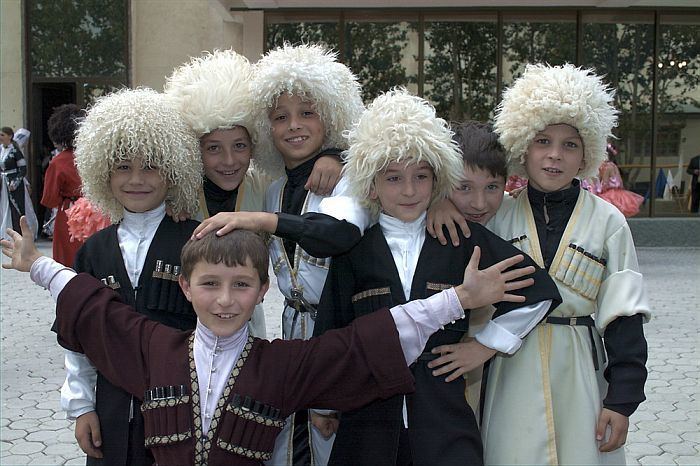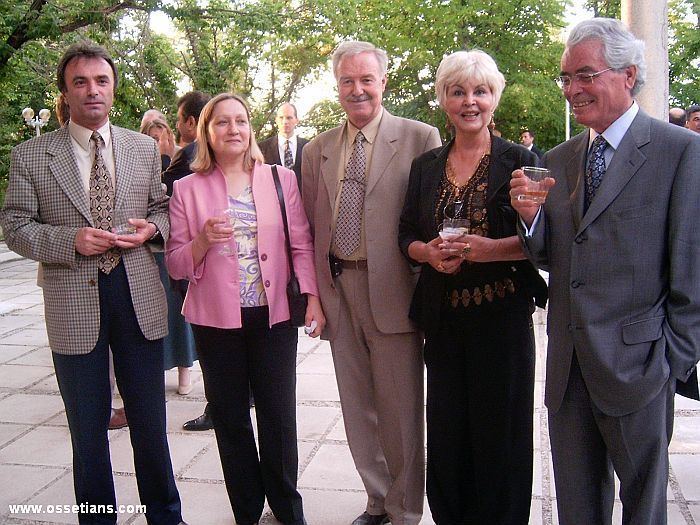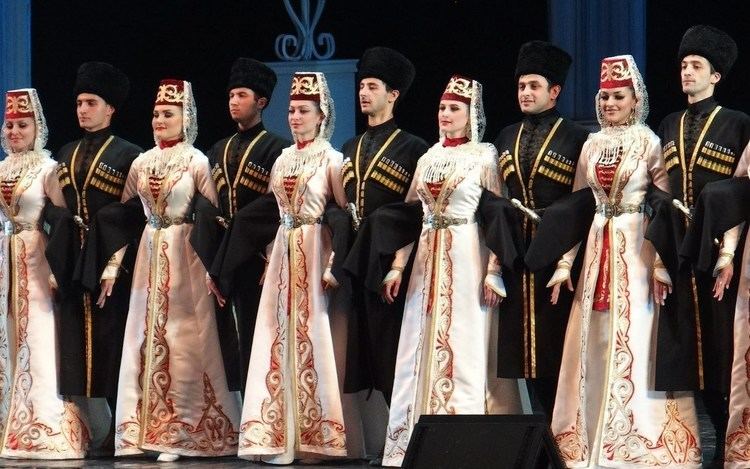Russia 528,515 Georgia(excluding South Ossetia) 14,426 Ukraine 4,830 | South Ossetia: 45,000 Turkey 20,000–100,000 Latvia 256 | |
 | ||
Ossetians alans iranian people
The Ossetians or Ossetes (Ossetian: ир, ирæттæ, ir, irættæ; дигорæ, дигорæнттæ, digoræ, digorænttæ) are an Iranian ethnic group of the Caucasus Mountains, indigenous to the region known as Ossetia in Eastern Europe. They speak Ossetic, an Eastern Iranian (Alanic) language of the Indo-European languages family, with most also fluent in Russian as a second language. The Ossetian language is neither closely related to nor mutually intelligible with any other language of the family today. Ossetic, a remnant of the Scytho-Sarmatian dialect group which was once spoken across the Steppe, is the only Iranian language native to Europe.
Contents
- Ossetians alans iranian people
- Multiethnic georgia ossetians
- Etymology
- Subgroups
- Mythology
- Prehistory Early Alans
- Middle Ages
- Modern history
- Language
- Religion
- History
- Livelihood
- Demographics
- Russian Census of 2002
- Genetics
- References

The Ossetians are mostly Eastern Orthodox Christian, with a minority Muslim or Ossetian Traditional beliefs.
The Ossetians mostly populate Ossetia, which is politically divided between North Ossetia–Alania in Russia, and South Ossetia, which since the 2008 South Ossetia war has been de facto independent from Georgia.

Their closest relatives, the Jász, live in the Jászság region within the north-western part of the Jász-Nagykun-Szolnok County in Hungary.

Multiethnic georgia ossetians
Etymology

The Ossetians and Ossetia received their name from the Russians, who adopted the Georgian designations Osi (ოსი) (sing., pl.: Osebi (ოსები)) and Oseti ("the land of Osi" (ოსეთი)), used since the Middle Ages for the single Iranian-speaking population of the Central Caucasus and probably based on the old Alan self-designation "As". As the Ossetians lacked any single inclusive name for themselves in their native language, these terms were accepted by the Ossetians themselves already before their integration into the Russian Empire.
This practice was put into question by the new Ossetian nationalism in the early 1990s, when the dispute between the Ossetian subgroups of Digoron and Iron over the status of the Digoron dialect made the Ossetian intellectuals search for a new inclusive ethnic name. This, combined with the effects of the Georgian-Ossetian conflict, led to the popularization of "Alania", the name of the medieval Sarmatian confederation, to which the Ossetians traced their origin, and inclusion of this name into the official republican title of North Ossetia in 1994.
Subgroups
Mythology
The folk beliefs of the Ossetian people are rooted in their Sarmatian origin and Christian religion, with the pagan gods transcending into Christian saints. The Nart saga serves the basic pagan mythology of the region.
Prehistory (Early Alans)
The Ossetians descend from the Alans, a Sarmatian tribe (Scythian subgroup of the Iranian ethnolinguistic group). About AD 200, the Alans were the only branch of the Sarmatians to keep their culture in the face of a Gothic invasion, and the Alans remaining built up a great kingdom between the Don and the Volga, according to Coon, The Races of Europe. Between AD. 350 and 374, the Huns destroyed the Alan kingdom, and a few survive to this day in the Caucasus as the Ossetes.
Middle Ages
In the 8th century a consolidated Alan kingdom, referred to in sources of the period as Alania, emerged in the northern Caucasus Mountains, roughly in the location of the latter-day Circassia and the modern North Ossetia–Alania. At its height, Alania was a centralized monarchy with a strong military force and had a strong economy which benefited from the Silk Road.
However, after the Mongol invasions of the 1200s the Alans were forced out of their medieval homeland south of the River Don in present-day Russia. Due to this, the Alans migrated towards the Caucasus mountains, where they would form three ethnographical groups; the Iron, Digoron, and Kudar. The Jassic people were a fourth group that migrated in the 13th century to Hungary.
Modern history
In recent history, the Ossetians participated in Ossetian–Ingush conflict (1991–1992) and Georgian–Ossetian conflicts (1918–1920, early 1990s) and in the 2008 South Ossetia war between Georgia and Russia.
Key events:
Language
The Ossetian language belongs to the Eastern Iranian (Alanic) branch of the Indo-European language family.
Ossetian is divided into two main dialect groups: Ironian (os. – Ирон) in North and South Ossetia and Digorian (os. – Дыгурон) of western North Ossetia. There are some subdialects in those two: like Tualian, Alagirian, Ksanian, etc. The Ironian dialect is the most widely spoken.
Ossetian is among the remnants of the Scytho-Sarmatian dialect group which was once spoken across the Steppe. The Ossetian language is not mutually intelligible with any other Iranian language.
Religion
Today, the majority of Ossetians, both from North and South Ossetia, follow Eastern Orthodoxy. In addition to Christianity, Ossetian ethnic religion is also widespread among Ossetians, with ritual traditions like sacrificing animals, holy shrines, non-Christian saints, etc. There are temples, known as kuvandon in most of the villages. According to the research service Sreda, North Ossetia is the primary location where Ossetian Paganism is practiced, and 29% of the population reported practicing pagan faiths in the 2012 Russian Census. Ætsæg Din is the Ossetian ethnic religion, rising in popularity since the 1980s.
History
Prior to the 10th century, Ossetians were a strictly Pagan group. However, they were partially Christianized by Byzantine missionaries in the beginning of the 10th century, By the 13th century, most of the Ossetians were Eastern Orthodox Christians as a result of Georgian influence and missionary work. Islam was introduced during the 18th century by the recently converted members of the Circassian Kabarday Tribe (to whom the religion was introduced by Tatars at the time) after taking over territory in western Ossetia occupied by the Digor, although it did not spread to the Ossetian people successfully.
Ossetia became part of the Russian Empire in 1774, which strengthened Orthodox Christianity considerably by sending missionaries there from the Russian Orthodox church. However, most of the missionaries chosen were churchmen from Christian Orthodox communities living in Georgia (including Armenians and Caucasus Greeks as well as ethnic Georgians) rather than from Russia, so as to avoid being seen by the Ossetians as too intrusive.
Livelihood
The northern Ossetians export lumber and cultivate various crops, mainly corn. The southern Ossetians are chiefly pastoral, herding sheep, goats, and cattle. Traditional manufactured products include leather goods, fur caps, daggers, and metalware.
Demographics
Outside of South Ossetia, There is also a significant number of Ossetians living in north-central Georgia in Trialeti. A large Ossetian diaspora lives in Turkey, and Ossetians have also settled in Belgium, France, Sweden, Syria, the United States (New York City, Florida and California as examples), Canada (Toronto), Australia (Sydney), and other countries all around the world.
Russian Census of 2002
The vast majority of Ossetians live in Russia (according to the Russian Census (2002)):
Genetics
The Ossetians are a unique ethnic group of the Caucasus, speaking an Indo-European language surrounded by Caucasian ethnolinguistic groups. The Y-haplogroup data indicate that North Ossetians are more similar to other North Caucasian groups, and South Ossetians are more similar to other South Caucasian groups, than to each other. Also, with respect to mtDNA, Ossetians are significantly more similar to some Iranian groups than to Caucasian groups. It is thus suggested that there is a common origin of Ossetians from the Proto-Iranian Urheimat, followed by subsequent male-mediated migrations from their Caucasian neighbours. Their genetic make-up is relatively heterogeneous as a result of extensive intermarriage with other ethnic groups in the region. In the Medieval, Imperial Russian, Soviet and contemporary periods it has been and is common to find Christian Orthodox Ossetian intermarriage with Georgians, Russians, Armenians, and Pontic Greeks, and Muslim Ossetian intermarriage with Meskhetian Turks, Kabardays, Ingushes, Chechens, and other Muslim communities of especially the North Caucasus.
